Is Sauna Good for Arthritis?
Are you suffering from arthritis? You're not alone. Reports suggest that more than 350 million people worldwide are going through the same struggle.
These stats are quite eye-opening, aren't they? Don't worry — a holistic wellness solution has been around for ages and might just be the answer to your joint pain woes: saunas!
These traditional healing spaces have been helping people relax, rejuvenate their minds and bodies, and even soothe achy joints after a taxing day.
In this article, we'll dive into the science-backed benefits of saunas, explain how they work for arthritis, share some handy tips to ensure you get the most out of your sauna sessions, and find out is sauna good for arthritis?
What Is Arthritis?
The Centers for Disease Control and Prevention (CDC) explains that arthritis isn't a singular disease but rather an umbrella term used to identify over 100 medical conditions that cause joint pain, stiffness, and inflammation.
Among the many types of arthritis, there are five primary ones, including:
-
Osteoarthritis involves the degradation of joint cartilage and the underlying bone.
-
Rheumatoid arthritis is an autoimmune disease affecting the joints' thin membrane lining, resulting in painful swelling, instability, and joint deformity.
-
Gout occurs when urate crystals accumulate at the base of the big toe.
-
Lupus causes multisystem inflammation and tissue damage.
-
Fibromyalgia affects the central nervous system, causing muscle stiffness and general fatigue.
These issues can severely impact the quality of life and reduce the range of motion in the affected joint, making it difficult to perform even basic tasks such as grabbing pencils or climbing the stairs.
Although there's no known cure for arthritis, several methods could help manage these symptoms. One common way is to take painkillers and non-steroidal anti-inflammatory drugs (NSAIDs) like ibuprofen to ease the discomfort.
Additionally, plenty of gentle exercises help reduce stiffness and keep joints flexible, like swimming, cycling, brisk walking, Tai Chi, and pilates.
If you're worried about the negative effects of long-term medication use or find exercise a bit too challenging due to joint stiffness, a sauna session might help you manage the pesky arthritis symptoms.
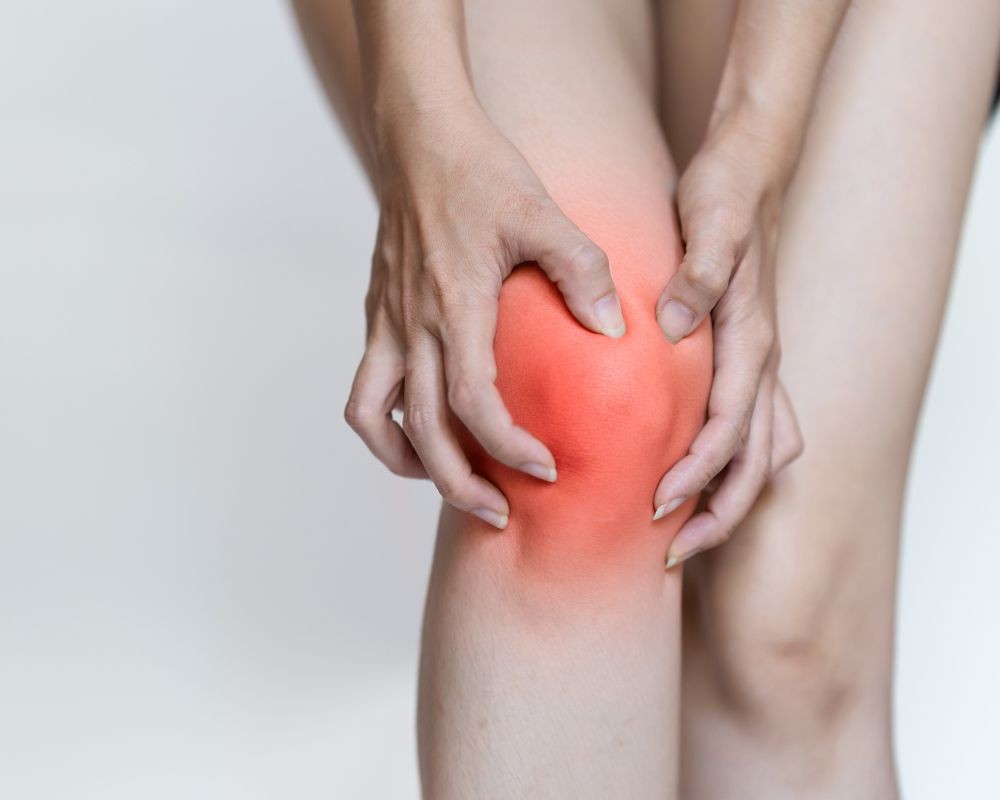
All About Saunas
Dating back to the Stone Age, saunas have been used across various cultures to cleanse the body, perform rituals and ceremonies, and soothe the spirit. These days, two types of saunas are available on the market: traditional and infrared saunas.
Traditional Saunas
Also known as Finnish saunas, traditional saunas are divided into two main types: dry saunas and steam saunas.
Dry saunas like Almost Heaven Pinnacle usually use a wood-fired stove or electric heater with a big pile of hot rocks, making a low-humidity, higher-heat space for you to sweat out your stress. These saunas usually have a high-temperature range between 150 to 195 degrees Fahrenheit.
Traditional saunas offer plenty of benefits, including stress and depression reduction, weight loss support, eczema management, better liver performance, and enhanced cardiovascular health.
Steam saunas feature a steam generator that heats water and injects it into the sauna. These saunas have high humidity, making them great for those with sensitive skin or respiratory problems like a sinus infection, asthma, or seasonal allergies.
Infrared Saunas
Unlike traditional saunas, infrared saunas like Health Mate Elevated Health use electromagnetic rays of different wavelengths to target the body directly.
This raises its core temperature more efficiently without heating the surrounding air as much. Since this heat penetrates your skin on a deeper level, it can help you detoxify and heal more quickly.
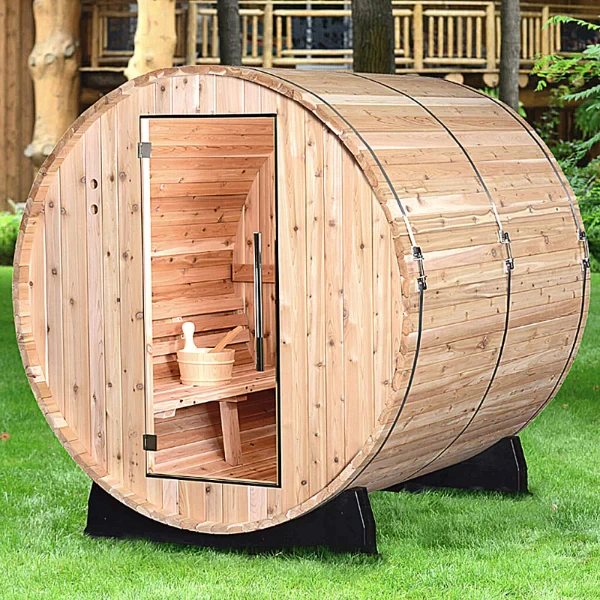
Is Sauna Good for Arthritis?
Yes, sauna use can indeed assist with arthritis and its associated symptoms. A 2009 study evaluated the effects of sauna treatment among patients with rheumatoid arthritis and ankylosing spondylitis. After taking regular sauna sessions for four weeks, the participants reported decreased pain, stiffness, and fatigue.
Arthritis often involves inflammation in the joints, making movement painful and challenging. This inflammation can lead to joint deformation when it reaches tendons and ligaments. Studies show that sauna bathing can help decrease serum C reactive protein that causes systematic inflammation and plays an active role in the onset and progression of various chronic inflammatory diseases.
If you're dealing with osteoarthritis, you likely know exactly how tricky it can be to manage. At first, it only causes mild discomfort in your joints when you climb stairs or kneel. Over time, this painful condition can lead to cartilage degradation, change bone shape, or provoke an inflammatory response. This eventually leads to limited mobility and balance issues.
Luckily, sauna bathing can help. A 2019 study explains that when performed at a moderate temperature of 122 degrees Fahrenheit, sauna yoga significantly improves flexibility, strength, endurance, and balance.
Besides arthritis, sauna treatments have also shown potential in relieving people suffering from chronic pain. A 2011 study demonstrates that patients with fibromyalgia who participated in sauna therapy experienced 31% to 77% reduction in pain after a 12 week program.
The Arthritis Foundation has underscored the importance of heat therapy in managing arthritis symptoms. It explains that sauna-induced heat increases blood circulation and delivers essential oxygen and nutrients to pain-afflicted joints, helping relieve pain and reduce stiffness. The heat also relaxes your muscles, which ultimately improves your joint movement.

How to Use Sauna for Arthritis
Follow these tips and techniques to maximize the benefits of your sauna therapy:
-
Timing is Everything: Plan your sauna sessions for times when your arthritis symptoms are usually severe. Many people find mornings tough as stiffness can be worse after sleep. A mid-morning or early afternoon session might work best.
-
Frequency Matters: The more time you spend in a sauna, the more benefits you'll get is just a myth. Start with a manageable schedule, such as two sessions per week. You can increase your tolerance to three to four sessions as your tolerance improves.
-
Duration and Temperature: Aim for 15–20 minutes of sauna heat at a comfortable temperature. Ideally, it should be between 160–194°F. Too hot and you risk overheating; too cold, you lose the benefits.
-
Try Aromatherapy: Healthline notes that essential oils such as lavender, eucalyptus, yarrow, Roman and German chamomile have pain and inflammation-reducing properties. Apply a few drops to your towel or mix it with the sauna water for an additional therapeutic effect.
-
Move Gently: The heat of the sauna will help to loosen up your joints and muscles. Use this to your advantage — perform gentle, arthritis-friendly stretches or movements like quadriceps stretches, side steps, and leg lifts while in the sauna to increase flexibility and decrease stiffness.
-
Hydrate: Keeping yourself hydrated before, during, and after your sauna session is critical. The heat can cause you to sweat out significant amounts of water, and staying hydrated will help prevent undue stress on your joints.
-
Respect Your Body: Everyone reacts differently to heat therapy. Listen to your body's signals. If you feel dizzy, overly tired, or unwell at any point, leave the sauna immediately.
Is Sauna Good for Arthritis?: Final Verdict
After a sweeping look between arthritis and sauna use, the verdict is clear: regular sauna sessions can benefit arthritis. The heat from a sauna increases blood circulation, reduces joint inflammation, and helps manage pain during gout attacks.
If you're considering making sauna sessions part of your arthritis management plan, check out MySaunaWorld's collection of traditional and infrared saunas. For more information, visit our website, or feel free to contact us!
SIGN UP. SAVE BIG.
Subscribe to be the first to know about our special monthly sauna sales, sent right to your inbox.

About the Author
Adam Fromson
Adam Fromson, co-founder of My Sauna World, loves saunas and their transformative health benefits. With years of experience exploring sauna culture and its impact on health and wellness, Adam is passionate about helping others discover the life-changing benefits of saunas for themselves.
Let customers speak for us
from 386 reviews
Good communication, easy delivery, easy set up, easy operation, great value. Recommended!
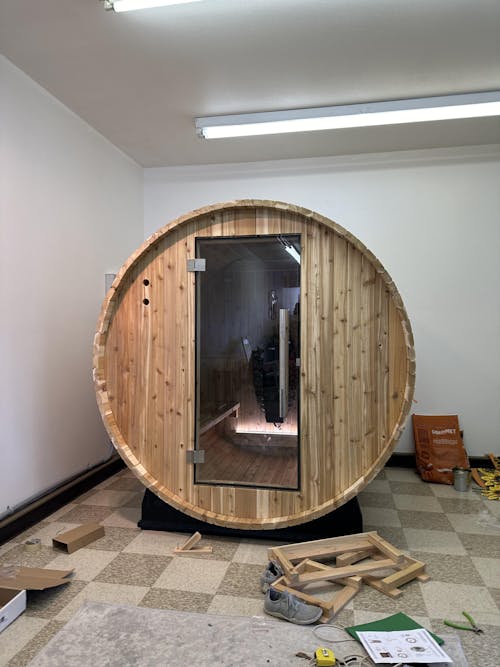
We ordered the 4 person barrel sauna and love it! We wanted a little extra space for the 2 of us/guests and it’s great. We could definitely fit 4 people in it if we needed. We use it every single day. It took about 10 weeks to get here because they build it specifically for the order. Putting the barrel together was fairly easy with 2 people. The electrical and the heater definitely required an electrician to install as we could have not done it alone.
We ordered the biggest heater (harvia spirit 8kw) and it heats up the sauna in about 15 mins inside our 40-50° garage. Overall this style of sauna is hotter and you sweat a lot faster than in an infrared sauna. I truly 10/10 recommend!
Pic is of us in the middle of building it.
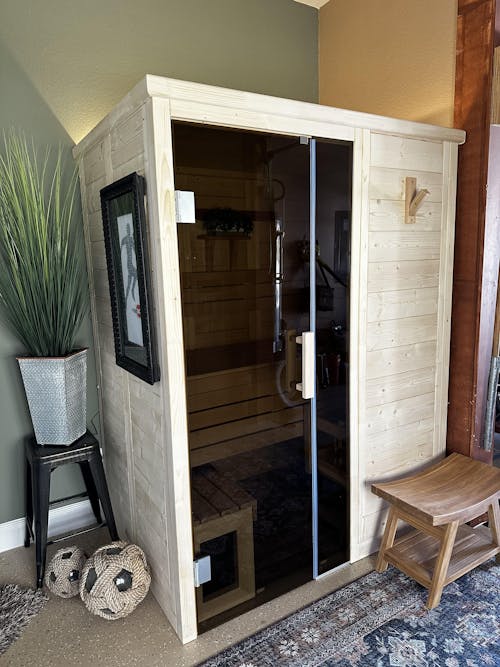
Took me about 6 hours over 2 evenings to assemble almost all by myself. Had a pro run a new circuit from my panel. Very well made and assembly was straightforward. Heater is well sized and reaches operating temperature in under 30 minutes.

Great sauna very easy to assemble

The salt panel was a great addition to our Madison Sauna. It has excellent grain which is accented by the amazing color lights that glow through the panel. Also when you hit the rocks with a splash of water you can feel the heat bounce off the panel. Great addition if you are considering this option.
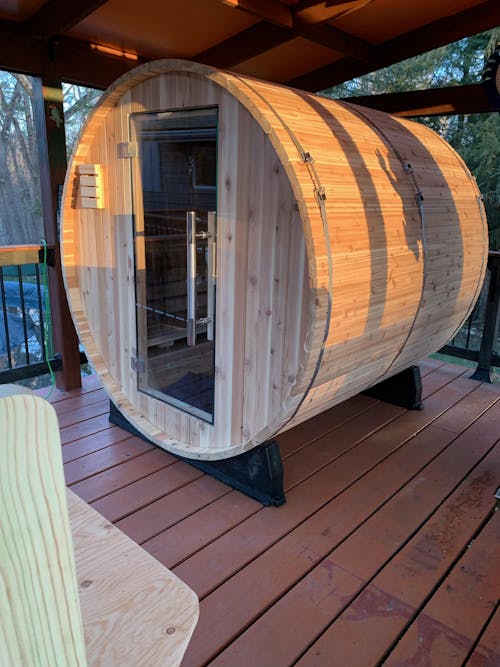
We can say enough about Sauna World there customer support is great! Our Pinnacle Sauna from Almost Heaven is epic.
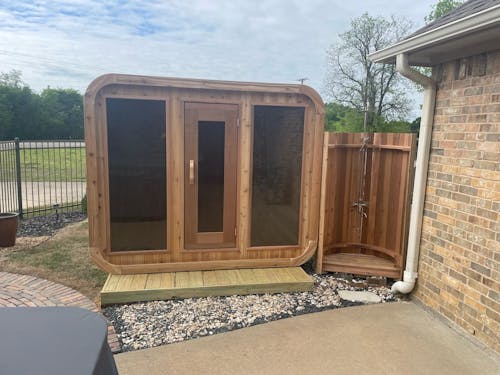
The finish and quality is outstanding and it was quick and easy to assemble.

We are thrilled with our mini pod!! It came well shipped and our friend assembled it in 11 hours! Wow! We cannot wait to get healthy and sauna it up!

Beautiful sauna!!! Much easier than I expected to assemble, took a total of 4 hours. Can't wait to get warm by the pool on those cool evenings. Customer service was excellent..

Purchased a 2 person Almost Heaven barrel sauna and were delighted with the product. The order process was quick and easy, the sauna arrived on-time, installation was simple, following the provided instructions, and the sauna is extremely high quality. We’ve used it daily for over 2 weeks and quite frankly I don’t know how we lived without it. If I had it to do over again I wouldn’t change a thing... except maybe purchasing a 4 person model to easier share with friends!

Great Customer Service and a breeze to put together.Excellent shipping and the Sauna is top notch, couldn’t be happier






























